2014年Alevel 数学试卷解析(精排版)
- 格式:pdf
- 大小:183.56 KB
- 文档页数:15
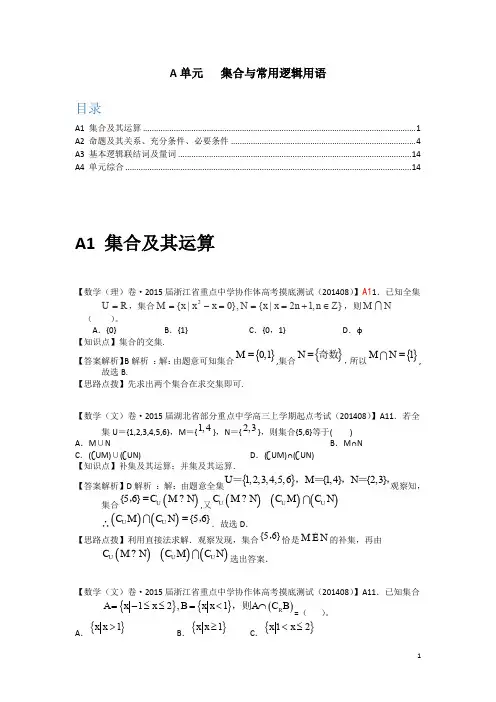
A 单元 集合与常用逻辑用语目录A1 集合及其运算 ............................................................................................................................ 1 A2 命题及其关系、充分条件、必要条件 .................................................................................... 4 A3 基本逻辑联结词及量词 .......................................................................................................... 14 A4 单元综合 . (14)A1 集合及其运算【数学(理)卷·2015届浙江省重点中学协作体高考摸底测试(201408)】A11.已知全集R U =,集合},12|{},0|{2Z n n x x N x x x M ∈+===-=,则N M( )。
A .{0}B .{1}C .{0,1}D .φ 【知识点】集合的交集.【答案解析】B 解析 :解:由题意可知集合{}0,1M =,集合{}N =奇数,所以{}1MN =,故选B.【思路点拨】先求出两个集合在求交集即可.【数学(文)卷·2015届湖北省部分重点中学高三上学期起点考试(201408)】A11.若全集U ={1,2,3,4,5,6},M ={1,4},N ={2,3},则集合{5,6}等于( ) A .M ∪N B .M∩N C .(∁UM)∪(∁UN) D .(∁UM)∩(∁UN) 【知识点】补集及其运算;并集及其运算. 【答案解析】D 解析 :解:由题意全集{}1,2,3,4,5,6{1,4}{2,3}U M N =,=,=,观察知,集合(){56}U C M N =?,,又()()()U UUC M N C M C N ?∴()(){56}UUC M C N =,.故选D .【思路点拨】利用直接法求解.观察发现,集合{56},恰是M N È的补集,再由()()()U UUC M N C M C N ?选出答案.【数学(文)卷·2015届浙江省重点中学协作体高考摸底测试(201408)】A11.已知集合{}{}()12,1R A x x B x x A C B =-≤≤=<⋂,则=( )。
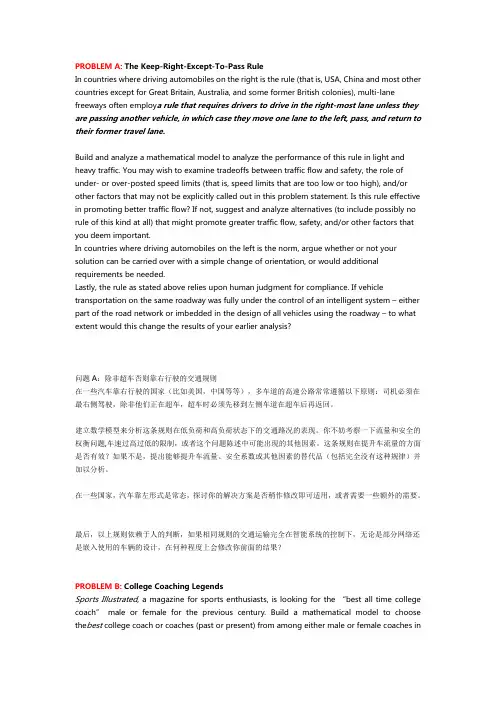
PROBLEM A: The Keep-Right-Except-To-Pass RuleIn countries where driving automobiles on the right is the rule (that is, USA, China and most other countries except for Great Britain, Australia, and some former British colonies), multi-lane freeways often employ a rule that requires drivers to drive in the right-most lane unless they are passing another vehicle, in which case they move one lane to the left, pass, and return to their former travel lane.Build and analyze a mathematical model to analyze the performance of this rule in light and heavy traffic. You may wish to examine tradeoffs between traffic flow and safety, the role of under- or over-posted speed limits (that is, speed limits that are too low or too high), and/or other factors that may not be explicitly called out in this problem statement. Is this rule effective in promoting better traffic flow? If not, suggest and analyze alternatives (to include possibly no rule of this kind at all) that might promote greater traffic flow, safety, and/or other factors that you deem important.In countries where driving automobiles on the left is the norm, argue whether or not your solution can be carried over with a simple change of orientation, or would additional requirements be needed.Lastly, the rule as stated above relies upon human judgment for compliance. If vehicle transportation on the same roadway was fully under the control of an intelligent system – either part of the road network or imbedded in the design of all vehicles using the roadway – to what extent would this change the results of your earlier analysis?问题A:除非超车否则靠右行驶的交通规则在一些汽车靠右行驶的国家(比如美国,中国等等),多车道的高速公路常常遵循以下原则:司机必须在最右侧驾驶,除非他们正在超车,超车时必须先移到左侧车道在超车后再返回。
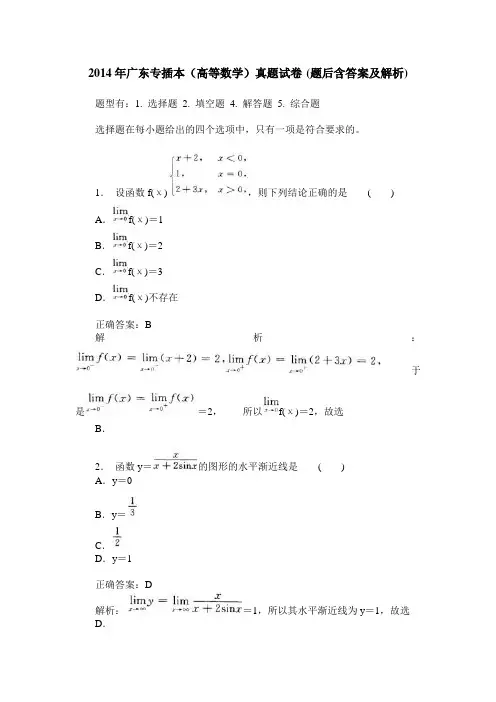
2014年广东专插本(高等数学)真题试卷(题后含答案及解析) 题型有:1. 选择题 2. 填空题 4. 解答题 5. 综合题选择题在每小题给出的四个选项中,只有一项是符合要求的。
1.设函数f(χ),则下列结论正确的是( )A.f(χ)=1B.f(χ)=2C.f(χ)=3D.f(χ)不存在正确答案:B解析:于是=2,所以f(χ)=2,故选B.2.函数y=的图形的水平渐近线是( )A.y=0B.y=C.D.y=1正确答案:D解析:=1,所以其水平渐近线为y=1,故选D.3.曲线y=lnχ+χ2+1的凸区间是( )A.(-∞,-1)B.(-1,0)C.(0,1)D.(1,+∞)正确答案:C解析:首先我们可得函数定义域为(0,+∞),y′=+χ,y?=,当y?<0时,在定义域内0<χ<1,所以其凸区间为(0,1).4.已知arctanχ2是函数f(χ)的一个原函数,则下列结论中,不正确的是( )A.f(χ)=B.当χ→0时,f(χ)和χ是同阶无穷小量C.∫0+∞f(χ)dχ=D.∫f(2χ)dχ=arctan4χ2+C正确答案:D解析:A项,f(χ)=(arctanχ2)′==2;B项,=2,所以f(χ)和χ是同阶无穷小量;C项,∫0+∞f(χ)dχ=arctanχ2∫0+∞=;D项,∫f(2χ)dχ=∫f(2χ)d2χ=arctan(2χ)2+C=arctan4χ2+C,故选D.5.交换二次积分I=∫01dχf(χ,y)dy的积分次序,则I=( ) A.B.C.D.正确答案:A解析:根据原积分表达式,得到如右图的积分区域,交换积分次序,即有I=f(χ,y)dχ,故选A.填空题6.=________.正确答案:2解析:7.f(χ)=χ2+2χ-1在区间[0,2]上应用拉格朗日(Lagrange)中值定理时,满足定理要求的ξ=_______.正确答案:1解析:f′(χ)=2χ+2,所以f′(ξ)=2ξ+2==4,ξ=1.8.若由参数方程所确定的函数y=y(χ)是微分方程=y+e -χ的解,则常数a=_______.正确答案:解析:由题有=-asect,y+e-χ=asect+e-lncost=asecχ+sect=(a+1)sect,∴由=y+e-χ得-asect=(a+1)sect,(2a+1)sect=0,2a+1=0,a=-.9.设二元函数z=ln(χy),则=_______.正确答案:0解析:10.微分方程y?+y′-12y=0的通解是y=_______.正确答案:C1e-4χ+C2e3χ解析:微分方程的特征方程是r2+r-12=0,得两特征根为r1=-4,r2=3,所以其通解为y=C1e-4χ+C2e3χ(C1,C2为任意常数).解答题解答时应写出推理、演算步骤。
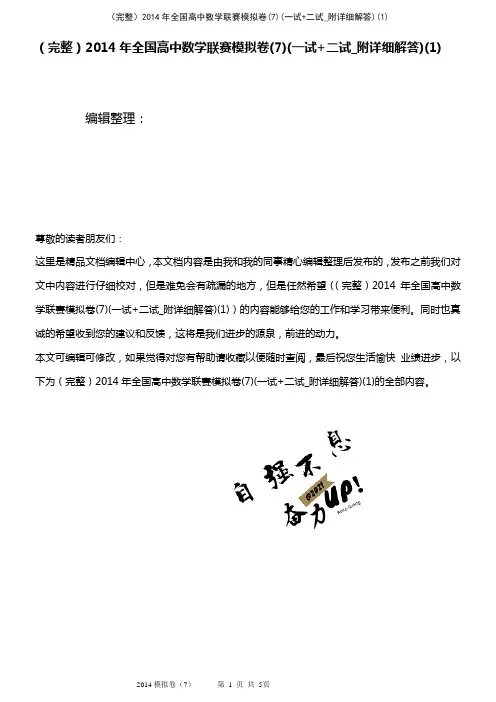
(完整)2014年全国高中数学联赛模拟卷(7)(一试+二试_附详细解答)(1) 编辑整理:尊敬的读者朋友们:这里是精品文档编辑中心,本文档内容是由我和我的同事精心编辑整理后发布的,发布之前我们对文中内容进行仔细校对,但是难免会有疏漏的地方,但是任然希望((完整)2014年全国高中数学联赛模拟卷(7)(一试+二试_附详细解答)(1))的内容能够给您的工作和学习带来便利。
同时也真诚的希望收到您的建议和反馈,这将是我们进步的源泉,前进的动力。
本文可编辑可修改,如果觉得对您有帮助请收藏以便随时查阅,最后祝您生活愉快业绩进步,以下为(完整)2014年全国高中数学联赛模拟卷(7)(一试+二试_附详细解答)(1)的全部内容。
2014年全国高中数学联赛模拟卷(7)第一试(考试时间:80分钟 满分:120分)姓名:_____________考试号:______________得分:____________一、填空题(本大题共8小题,每小题8分,共64分)__________1. 集合{2135}A x a x a =+≤≤+,{333}B x x =≤≤,()A A B ⊆, 则a 的取值范围是___________2. 某人投两次骰子, 先后得到点数,m n , 用来作为一元二次方程20x mx n ++=的系数, 则使方程有实根的概率为______________ 3. 过四面体ABCD 的顶点D 作半径为1的球,该球与四面体ABCD于点D ,且与平面ABC 相切。
若45,AD BAD CAD BAC =∠=∠=︒∠=则四面体ABCD 的外接球的半径r =________4。
如图, ,M N 分别为正六边形ABCDEF 的对角线AC ,CE 的内分点, 且错误!=错误!=λ, 若B ,M ,N 三点共线,则λ=______________ 5. 已知2()(3f x x b x a b =++-是偶函数,则函数图像与y 轴交点的纵坐标的最大值是 6. 对所有的实数x 及1t ≤≤均有222(2)()x t x at ++++>错误!, 则实数a 的取值范围是 ______ 。
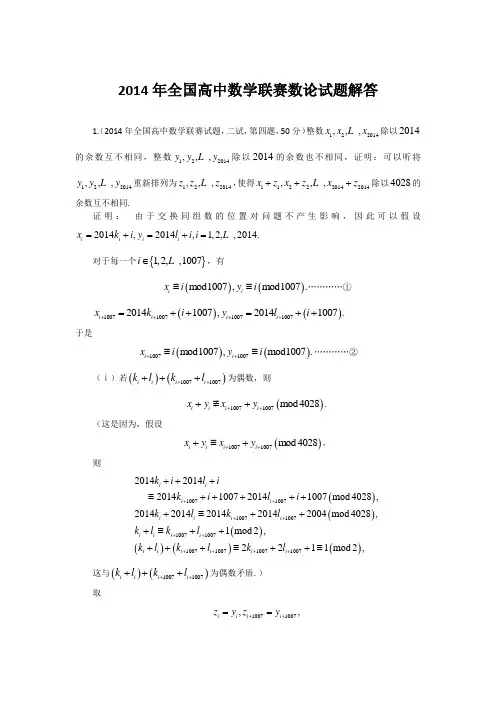
2014年全国高中数学联赛数论试题解答1.(2014年全国高中数学联赛试题,二试,第四题,50分)整数122014,,,x x x 除以2014的余数互不相同,整数122014,,,y y y 除以2014的余数也不相同,证明:可以听将122014,,,y y y 重新排列为122014,,,z z z ,使得112220142014,,,x z x z x z +++除以4028的余数互不相同.证明: 由于交换同组数的位置对问题不产生影响,因此可以假设2014,2014,1,2,,2014.i i i i x k i y l i i =+=+=对于每一个{}1,2,,1007i ∈,有()()mod1007,mod1007.i i x i y i ≡≡…………①()()100710071007100720141007,20141007.i i i i x k i y l i ++++=++=++于是()()10071007mod1007,mod1007.i i x i y i ++≡≡…………②(ⅰ)若()()10071007i i i i k l k l +++++为偶数,则()10071007/mod4028i i i i x y x y +++≡+.(这是因为,假设()10071007mod4028i i i i x y x y +++≡+,则()()()()()()1007100710071007100710071007100710071007201420142014100720141007mod 4028,20142014201420142004mod 4028,1mod 2,2211mod 2,i i i i i i i i i i i i i i i i i i k i l ik i l i k l k l k l k l k l k l k l +++++++++++++≡++++++≡+++≡+++++≡++≡ 这与()()10071007i i i i k l k l +++++为偶数矛盾.) 取10071007,,i i i i z y z y ++==则()10071007/mod4028.i i i i x z x z +++≡+(ⅱ)若()()10071007i i i i k l k l +++++为奇数,则()10071007/mod4028.i i i i x y x y +++≡+(这是因为,假设()10071007mod4028,i i i i x y x y +++≡+则()()()()()()100710071007100710071007100710071007201420141007201410072014mod 4028,2014201420142014mod 4028,mod 2,220mod 2,i i i i i i i i i i i i i i i i i i k i l i k i l i k l k l k l k l k l k l k l +++++++++++++≡+++++≡++≡++++≡+≡ 这与()()10071007i i i i k l k l +++++为奇数矛盾.) 取10071007,,i i i i z y z y ++==则()10071007/mod4028.i i i i x z x z +++≡+由(ⅰ)和(ⅱ)得,对每一{}1,2,,1007i ∈,()()()()10071007100710071007,2|,2|/i i i i i i i i i i i y k l k l z y k l k l ++++++++⎧⎪=⎨+++⎪⎩()()()()100710071007100710071007,2|,2/|i i i i i i i i i i i y k l k l z y k l k l +++++++++⎧⎪=⎨+++⎪⎩ 易知122014,,,y y y 可重新排序为122014,,,z z z ,且对每一{}1,2,,1007i ∈,都有()10071007/mod4028.i i i i x z x z +++≡+…………③由①②两式得,对每一{}1,2,,1007i ∈有()100710072mod1007.i i i i x z x z i +++≡+≡…………④下面证明,对每一{}1,2,,1007i ∈及每一{}1,2,,1007j ∈,都有()10071007/mod4028.i i j j x z x z +++≡+…………⑤假设对某一{}1,2,,1007i ∈及某一{}1,2,,1007j ∈,有()10071007mod4028,i i j j x z x z +++≡+则()10071007mod1007.i i j j x z x z +++≡+从而有④式得()()22mod1007,mod1007,.i j i j i j ≡≡=于是,()10071007mod4028.i i i i x z x z +++≡+这与③式矛盾. 下面证明,当11007i j ≤<≤时,有()/mod4028i i j j x z x z +≡+…………⑥且()1007100710071007/mod4028..i i j j x z x z +++++≡+…………⑦假设有满足11007i j ≤<≤的整数,i j ,使得()mod4028i i j j x z x z +≡+,则()mod1007i i j j x z x z +≡+,从而由④式得()()22mod1007,mod1007.i j i j ≡≡.这与11007i j ≤<≤矛盾.故⑥式成立.假设有满足11007i j ≤<≤的整数,i j ,使得()1007100710071007mod4028i i j j x z x z +++++≡+,则()1007100710071007mod1007i i j j x z x z +++++≡+,从而有④式得()()22mod1007,mod1007.i j i j ≡≡这与11007i j ≤<≤矛盾.故⑦式成立.由⑤⑥⑦三式得112220142014,,,x z x z x z +++除以4028的余数互不相同.2.(2014年全国高中数学联赛B 卷试题,加试题,第三题,50分)给定正整数2k ≥,,a b 是非零整数,且a b +为奇数,假定方程k k a x b y a b -=-有整数解,x y ,其中0 2.x y <-≤证明:a b -是某个整数的k 次幂.证明:设11,a da b db ==,其中(),d a b =,则()11, 1.a b =由k k a x b y a b -=-得()11111,k k k dax b y a b --=-所以()111|,k d a b --于是 111.k d a b --…………①又因为()(),k k k k k a b a x b y a x y a b y -=-=-+-且()()|k ka b a b --,所以()()|.k a b a x y --由假定a b +为奇数得,a b -也为奇数,而02x y <-≤,从而(), 1.a b x y --=于是()|.ka b a -从而()()()1111111|,|.kk k da db da a b d a ---由()11,1a b =可得()111,1a b a -=,从而()111|,k a b d--于是111.k a b d --…………②由①②两式得111.k a b d--=于是,1111,k a b da db d a b d -=-=-=即a b -是整数d 的k 次幂,这就是我们所要证明的.。
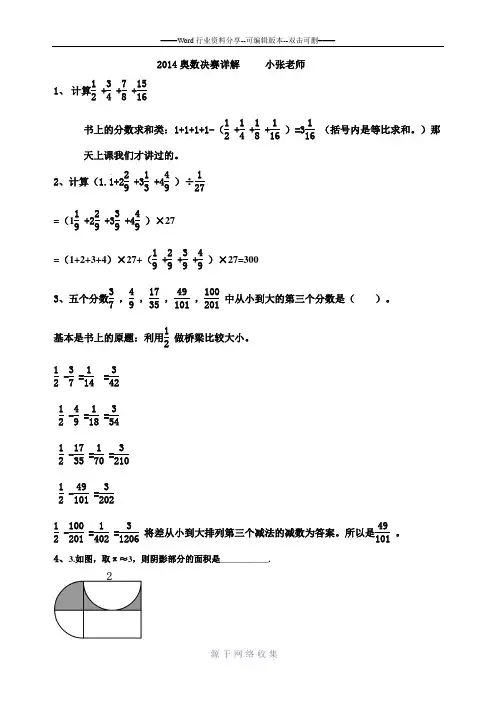
2014奥数决赛详解 小张老师 1、 计算12 +34 +78 +1516 书上的分数求和类:1+1+1+1-(12 +14 +18 +116 )=3116(括号内是等比求和。
)那天上课我们才讲过的。
2、计算(1.1·+229 +313 +449 )÷127 =(119 +229 +339 +449)×27 =(1+2+3+4)×27+(19 +29 +39 +49)×27=300 3、五个分数37 ,49 ,1735 ,49101 ,100201中从小到大的第三个分数是( )。
基本是书上的原题:利用12做桥梁比较大小。
12 -37 =114 =34212 -49 =118 =35412 -1735 =170 =321012 -49101 =320212 -100201 =1402 =31206 将差从小到大排列第三个减法的减数为答案。
所以是49101。
4、3.如图,取π≈3,则阴影部分的面积是___________.答案为:1.255、将数字1,2,3,4,5,6分别填入下列算式中的6个[ ]中,使算式成立。
(此题有多个解,填入一个即可)。
[ ]×( 7-[ ])÷[ ]-[ ]+[ ]= [ ]解答:6×(7-3)÷4-3+2=5 答案不唯一。
6、由棱长为1厘米的若干个立方体堆成一个长、宽、高分别是11、9、7厘米的长方体。
将它的表面全部涂上红色,然后将只有一个面是红色的立方体取出来。
再将取出来的立方体堆成一个长宽高都不同的实心长方体,那么这个新长方体的表面积的最大值是()立方厘米。
解答:(11-2)×(9-2)=63 (11-2)×(7-2)=45(9-2)×(7-2)=35(63+45+35)×2=286 (体积数)分解286=11×13×2 极差越大表面积越大所以长宽高为143、2、1表面积=862.(知识点,前次课我们才讲了)7、矿泉水、果汁、豆奶三种饮料共计180瓶。
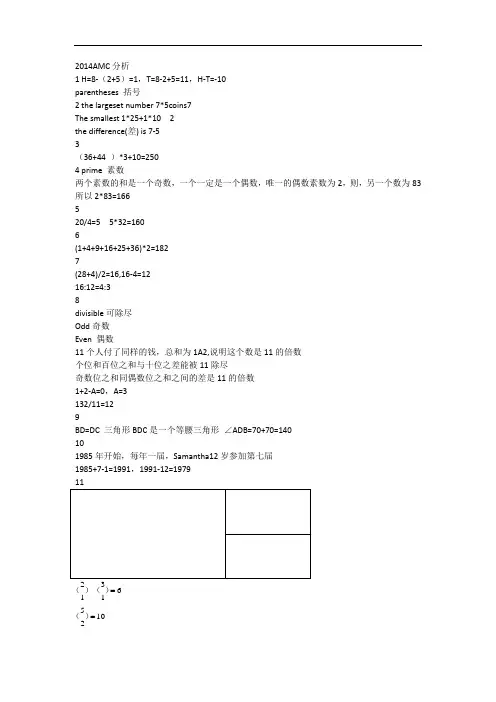
2014AMC 分析1 H=8-(2+5)=1,T=8-2+5=11,H -T=-10parentheses 括号2 the largeset number 7*5coins7The smallest 1*25+1*10 2the difference(差) is 7-53(36+44 )*3+10=2504 prime 素数两个素数的和是一个奇数,一个一定是一个偶数,唯一的偶数素数为2,则,另一个数为83 所以2*83=166520/4=5 5*32=1606(1+4+9+16+25+36)*2=1827(28+4)/2=16,16-4=1216:12=4:38divisible 可除尽Odd 奇数Even 偶数11个人付了同样的钱,总和为1A2,说明这个数是11的倍数个位和百位之和与十位之差能被11除尽奇数位之和同偶数位之和之间的差是11的倍数1+2-A=0,A=3132/11=129BD=DC 三角形BDC 是一个等腰三角形 ∠ADB=70+70=140101985年开始,每年一届,Samantha12岁参加第七届1985+7-1=1991,1991-12=1979611=))(( 1025=)(10-6=412概率第一种方法6121*31= 第二种方法6121*21*31*31*3=! 13Integers 整数通过举例14Traperzoid 梯形三角形DCE 的面积和长方形ABCD 面积相等 长方形的面积为5*6=30三角形面积为5*CE/2=30=>CE=12根据勾股定理1312522=+15 circumference 圆周线 arcs 弧圆被分成12份,每一份的弧度相等,圆心角也相等 每一份的角度是30度OI=OG ,∠I0G=60,∠OIG=∠OGI=60,Y=60AO=EO ,∠AOE=120,x=30X+y=90167+6=5+4+3+2+1=2828*2=568*4=3232+56=8817时间 1/3(1/2)/2=1/4剩余时间1/3-1/4=1/12(1/2)/(1/12)=618 A=B=161214=)( C=83161*6*)21(424==CD=21**221414 )()(C 19 1个小正方体在中心,其余在外围,9*6=54 5/54205*3=153*3*3.14/4=7.0652*2*3.14/4=3.141*1*3.14/4=0.78515-7.065-3.14-0.786=4.01B217+4+A+5+2+B+1=19+A+BA+B=23+2+6+A+B+4+C=15+A+B+CA+B+C=3C=12210a+ba*b+a+b=10a+bb=9。
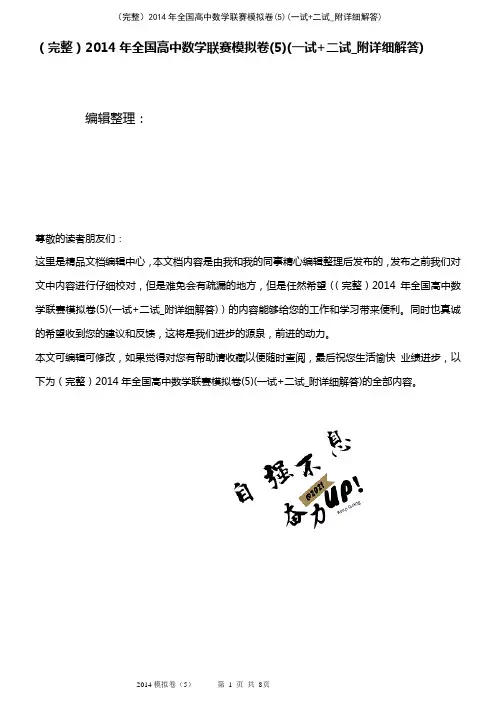
(完整)2014年全国高中数学联赛模拟卷(5)(一试+二试_附详细解答) 编辑整理:尊敬的读者朋友们:这里是精品文档编辑中心,本文档内容是由我和我的同事精心编辑整理后发布的,发布之前我们对文中内容进行仔细校对,但是难免会有疏漏的地方,但是任然希望((完整)2014年全国高中数学联赛模拟卷(5)(一试+二试_附详细解答))的内容能够给您的工作和学习带来便利。
同时也真诚的希望收到您的建议和反馈,这将是我们进步的源泉,前进的动力。
本文可编辑可修改,如果觉得对您有帮助请收藏以便随时查阅,最后祝您生活愉快业绩进步,以下为(完整)2014年全国高中数学联赛模拟卷(5)(一试+二试_附详细解答)的全部内容。
2014年全国高中数学联赛模拟卷(5)第一试(考试时间:80分钟 满分:120分)姓名:_____________考试号:______________得分:____________一、填空题(本大题共8小题,每小题8分,共64分)__________1。
正八边形87654321A A A A A A A A 边长为1,任取两点j i A A ,则21A A A A j i ⋅最大值为__________ 2。
若ii ikk k k xa x x f C-==∑∑=--=200720070200702007)3()1()(,则∑=20071k k a =_________3。
若关于x 的方程0142)6(22222=+-+++-+-b a b a x b b a x 的两个实数根21,x x 满足,1021≤≤≤x x 则4422+++a b a 的最小值为______________, 最大值分别为____________ 4. 设P 双曲线错误!-错误!=1右支上一动点,过P 向两条渐近线作垂线,垂足分别为点B A ,,若点B A ,始终在第一、第四象限内,则双曲线离心率e 的取值范围是___________。
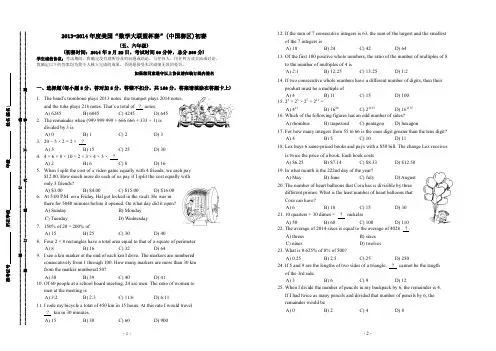

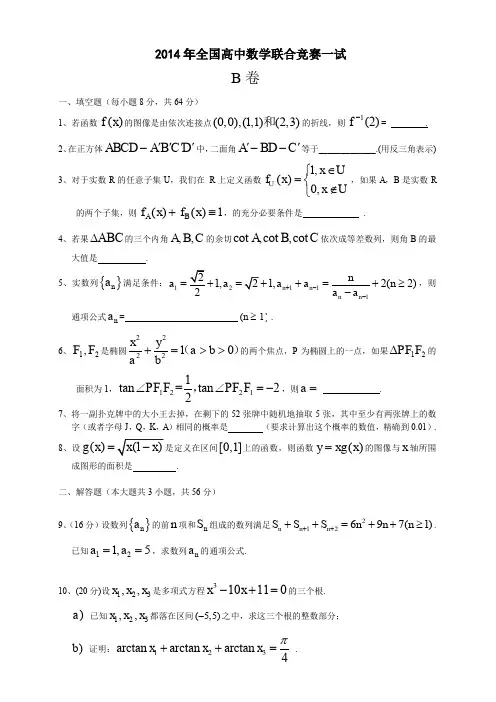
2014年全国高中数学联赛模拟卷(7)第一试(考试时间:80分钟 满分:120分)姓名:_____________考试号:______________得分:____________一、填空题(本大题共8小题,每小题8分,共64分)__________1. 集合{2135}A x a x a =+≤≤+,{333}B x x =≤≤,()A A B ⊆, 则a 的取值范围是___________2. 某人投两次骰子, 先后得到点数,m n , 用来作为一元二次方程20x mx n ++=的系数, 则使方程有 实根的概率为______________ 3. 过四面体ABCD 的顶点D 作半径为1的球,该球与四面体ABCD 的外接球相切 于点D ,且与平面ABC 相切。
若23,45,60AD BAD CAD BAC =∠=∠=︒∠=︒,则四面体ABCD 的外接球的半径r =________4. 如图, ,M N 分别为正六边形ABCDEF 的对角线AC ,CE 的内分点,且AM AC =CNCE =λ, 若B ,M ,N 三点共线,则λ=______________ 5. 已知22()(4)3f x x b a x a b =+--+-是偶函数,则函数图像与y 轴交点的纵坐标的最大值是6. 对所有的实数x 及12t ≤≤均有222(2)()x t x at ++++>18, 则实数a 的取值范围是 ______ .7. 定义“n 次幂平均三角形”:如果△ABC 的三边满足等式:1()2n n n a c b +=(n Z ∈), 则称△ABC 为 “n 次幂平均三角形”. 如果△ABC 为“3次幂平均三角形”, 则角B 的最大值是 ______ .8. 设,,u v w 为复数, 其中()22,3,25w a bi a b a b =+≥+=,3u w v -=, 若1v =, 则当u 的辐角主值最小时,uw的值为_____________ 二、解答题(本大题共3小题,第9题16分,第10、11题20分,共56分) 9.定义域为实数集R 的函数f (x )同时满足以下3个条件:①x >0时,f (x )>0,②f (1)=2,③对任意m ,n R ∈,都有f (m +n ) =f (m )+f (n ).设集合22{(,)(3)(4)24}A x y f x f y =+≤,{(,)()()(3)0}B x y f x f ay f =-+=,21{(,)|()()()}2C x y f x f y f a ==+,若A ∩B ≠Ф 且A ∩C ≠Ф,试求实数a 的取值范围.10. 已知双曲线方程1222=-y x ,是否存在过焦点的直线l ,交双曲线于A 、B 两点,使得∠AOB =π2. 若存在,求出l 的方程;若不存在,请说明理由。
EDEXCEL GCE MATHEMATICSGeneral Instructions for Marking1.The total number of marks for the paper is 75.2.The Edexcel Mathematics mark schemes use the following types of marks:•M marks: method marks are awarded for ‘knowing a method and attempting to apply it’, unless otherwise indicated.•A marks: Accuracy marks can only be awarded if the relevant method (M) marks have been earned.•B marks are unconditional accuracy marks (independent of M marks)•Marks should not be subdivided.3.AbbreviationsThese are some of the traditional marking abbreviations that will appear in the mark schemes.•bod – benefit of doubt•ft – follow through•the symbol will be used for correct ft•cao – correct answer only•cso - correct solution only. There must be no errors in this part of the question to obtain this mark•isw – ignore subsequent working•awrt – answers which round to•SC: special case•oe – or equivalent (and appropriate)•dep – dependent•indep – independent•dp decimal places•sf significant figures•¿The answer is printed on the paper•The second mark is dependent on gaining the first mark4.All A marks are ‘correct answer only’ (cao.), unless shown, for example, as A1 ft toindicate that previous wrong working is to be followed through. After a misread however, the subsequent A marks affected are treated as A ft, but manifestly absurd answersshould never be awarded A marks.5.For misreading which does not alter the character of a question or materially simplify it,deduct two from any A or B marks gained, in that part of the question affected.6.If a candidate makes more than one attempt at any question:•If all but one attempt is crossed out, mark the attempt which is NOT crossed out.•If either all attempts are crossed out or none are crossed out, mark all the attempts and score the highest single attempt.7.Ignore wrong working or incorrect statements following a correct answer.General Principles for Core Mathematics Marking(But note that specific mark schemes may sometimes override these general principles). Method mark for solving 3 term quadratic: 1.Factorisationc pq q x p x c bx x =++=++where ),)(()(2, leading to x = …a mn c pq q nx p mx c bx ax ==++=++and where ),)(()(2, leading to x = …2.FormulaAttempt to use the correct formula (with values for a , b and c ).pleting the squareSolving02=++c bx x :0,022≠=±±⎟⎠⎞⎜⎝⎛±q c q b x , leading to x = …Method marks for differentiation and integration: 1.DifferentiationPower of at least one term decreased by 1. (1−→n nx x )2.IntegrationPower of at least one term increased by 1. (1+→n nxx )Use of a formulaWhere a method involves using a formula that has been learnt, the advice given in recent examiners’ reports is that the formula should be quoted first. Normal marking procedure is as follows:Method mark for quoting a correct formula and attempting to use it, even if there are mistakes in the substitution of values.Where the formula is not quoted, the method mark can be gained by implication from correct working with values, but may be lost if there is any mistake in the working.Exact answersExaminers’ reports have emphasised that where, for example, an exact answer is asked for, or working with surds is clearly required, marks will normally be lost if the candidate resorts to using rounded decimals.Answers without workingThe rubric says that these may not gain full credit. Individual mark schemes will give details of what happens in particular cases. General policy is that if it could be done “in your head”, detailed working would not be required.Notes(a) M1: Attempt to differentiate – power reduced 1n n→or 3x becomes 3x x−A1: two correct terms ( of the three shown). They may be unsimplifiedA1: fully correct and simplified then isw (any equivalent simplified form acceptable) (b) M1: Attempt to integrate original f(x)– one power increased 1n nx x+→A1: Two of the four terms in x correct unsimplified – (ignore lack of constant here) A1: Three terms correct unsimplified – (ignore lack of constant here)A1: All correct simplified with constant – allow -1x for –xN.B Integrating answer to part (a) is M0Notes(a)(b) (c)M1: Attempt to use formula correctly (implied by first term correct, or given as 0.67, or third term following through from their second etc) A1: two correct answersA1: 3 correct answers (allow 0.6 recurring but not 0.667) Look for the values. Ignore the label r u B1: cao (NB Use of AP is B0)M1:Uses sum of at least 3 terms found from part (a)) (may be implied by correct answer). Attempt to sum an AP here is M0.A1: obtains 33(sum of three adjacent terms)×or 11(sum of nine adjacent terms)× A1: - 11 cao ( -11 implies both A marks) N.B. Use of n = 99 is M1A0A0(b)to give printed answer including = 0M1: Solving the correct quadratic equation (allow sign errors), by the usual methods (see notes) – implied by correct answersA1: Both answers needed – allow 0.25 and awrt – 0.33M1 Uses inverse cosine to obtain two correct values for x for their values of cos x e.g. (75.5 and 109.4 or 109.5) or (75.5 and 284.5) or (109.5 and 250.5) – allow truncated answers or awrt here.A1: All four correct – allow awrt. Ignore extra answers outside range but lose last A mark for extra answers inside rangeAnswers in radians are 1.3, 5.0, 1.9 and 4.4 Allow M1A0 for two or more correct asnwersQuestion Number SchemeMarks 8.kx 2x ++82k +()7=Uses 2−4b ac with a k ,b ==8 and attempt at c =2(k + 7)M1 b a −=c 464−56k −228k or 6456k =+8k 2o .e . A1 Attempts to solve 2"7k k +−8=0"to give k =dM1 ⇒Critical values, k 1,=−8.A1cso M1 Uses 4b a −<c 0or 22b 4<ac or ac 4 −b 2>02k k +−78>0 gives 1(or)k k ><8−M1 A1 [7]7 marksNotesM1: Attempts 24b ac − for ,8a k b == and c = 2(k +7) or attempt at c from quadratic = 0 (may omit bracket or make sign slip or lose the 2, so 2k +7 or k + 7 for example)oruses quadratic formula to solve equation or uses on two sides of an equation or inequation A1: Correct three term quadratic expression for 24b ac − - (may be under root sign)dM1: Uses factorisation, formula, or completion of square method to find two values for k , or finds two correct answers with no obvious method for their three term quadratic A1: Obtains 1 and -8M1: states 22404b ac or b ac −<< anywhere (may be implied by the following work)M1: Chooses outside region ( k < Their Lower Limit Their Upper Limit k >) for appropriate 3 term quadratic inequality . Do not award simply for diagram or table.A1: 1or 8k k ><− - allow anything which clearly indicates these regions e.g. (,8)−∞− or (1,)∞ 1,8k k ><− is A1 but k > 1 and k < -8 is A0but x > 1, x < -8 is A0 ( only lose 1 mark for using x instead of k ) and 1(or)8k k ≥≤−is A0 Also 1< k < -8 is M1 A0N.B. Lack of working: If there is no mention of 2240or 4b ac b ac −<< then just the correct answer 1,8k k ><− can imply the last M1M1A1 1,8k k ≥≤− can imply M0M1A01,8k k ><− can imply M1M1A0 Anything else needs to apply schemeMethod markfor harmoniccurve i.e. anysine or cosinecurveAccuracy forcorrect sectionand positionrelative to the (0 , ½ ) ;Notes for Question 14(a) M1: Puts equations equaldM1 Solves quadratic to obtain x =A1: both answers correctdM1: finds y =A1: both correctB1: Correct integration of one of the quadratic expression (given in the mark scheme) to give one of the givencubic expression (ignore limits). Allow correct answer even if terms not collected nor simplified. Sign errors (b)subtracting in alternative methods before integration gain B0B1: Line intersection correct (see 1.5)B1: curve intersection correct (see 5)M1: Uses correct combination of correct areas (allow numerical slips) so(i)Area of triangle using their “6” – their “1.5” times their “9” MINUS area beneath curve between their 5 and their 6(ii) Area of triangle using their “5” – their “1.5” times their “7” PLUS area between curves between their 5 and their 6(iii) Subtracts area below axis from area between curvesTHEIR 1.5 must NOT BE ZERO!M1: Attempts second area (so area of a triangle relevant to the method- or integral of the linear functionwith relevant limits- or integral of original quadratic in second alternative method)M1: Uses their limits (even zero) correctly on any cubic expression (subtracting either way round) Can begiven for wrong limits or for wrong areas. No evidence of substitution of limits is M0A1: Final answer – not decimal – csoAlternative methods to part (d)(i)Use equation x y 22++ax +by +c =0and substitute three points, usually (0,3), (6,11) and another point on the circle maybe (-2,17) or (-8,9) - not point Z Solves simultaneous equations a = 2, b = -20 and c = 51(ii) Uses centre to write a = and b = (doubles x coordinate and y coordinate respectively, "2"and ±±"20")Obtains a = 2 and b = -20 (or just writes these values down so these answers imply M1A1) Completes method to find c , (could substitute one of the points on the circle) or could find r Accurate work e.g. r 2=50 or e.g. +x y 222+−x 20y =(−8)2+2+928×−−20×9 = c = 51M1 dM1A1,A1,A1 M1 A1 dM1 A1 A1。